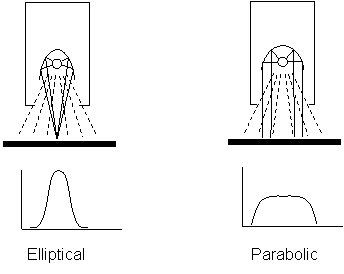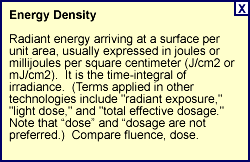Guide to UV Measurement
Reflectors
Reflectors are a critical component of most lamps used in UV processes. Bulbs are isotropic sources of radiation; the photon emitted by an excited mercury atom is in a random direction so that bulb emission occurs in all directions with equal probability. As mentioned above, the photons emitted by the mercury atoms are a required element of the chemical reaction that needs to occur and if the UV radiation does not impinge on the chemistry so it can be absorbed, it will be wasted energy. In order to capture and recycle a large fraction of this wasted energy, reflectors are used which redirect the radiation in a more desirable direction – back towards the chemistry. The only requirements for a reflector are that it is able to withstand the high temperatures and it has a high reflectivity in the UV spectral region of interest. Polished aluminum reflectors are the most commonly used.
Reflector shapes can vary. Most common are elliptical reflectors that focus the reflected energy at some characteristic focal distance. Elliptical reflectors are used to maximize the energy delivered per unit area per unit time, including IR energy. Parabolic reflectors are designed to spread the reflected energy over a larger area. They do not have a defined focal distance. Representative radiation profiles that a moving substrate is subjected to as it passes under the two reflector types are indicated below –

Note that the peak under an elliptical reflector is higher than that of a parabolic reflector. The amplitude of the energy reaching a moving substrate per unit area per unit time is the irradiance and the peak value is called the peak irradiance. Even though the shapes of the two energy profiles differ significantly, the area under the curves that represents the energy density on the substrate can be comparable and is dependent on other factors relating to the housing design.
Since the radiant energy from most UV sources includes a large IR component, heat is often a concern and steps must be taken to minimize thermal effects that can lead to product distortion and other visual defects and, in the extreme, to a fire hazard. One way is to use a parabolic reflector since it spreads the energy over a larger area. Unfortunately, this also reduces the peak irradiance and can reduce the cure efficiency of the source for its intended application. One common way to eliminate a large portion of the IR component reaching the substrate is to use a reflector having a dichroic coating. A dichroic-coated reflector will selectively transmit or absorb IR yet still maintains a high UV reflectivity so that the reflected energy is UV enriched.
